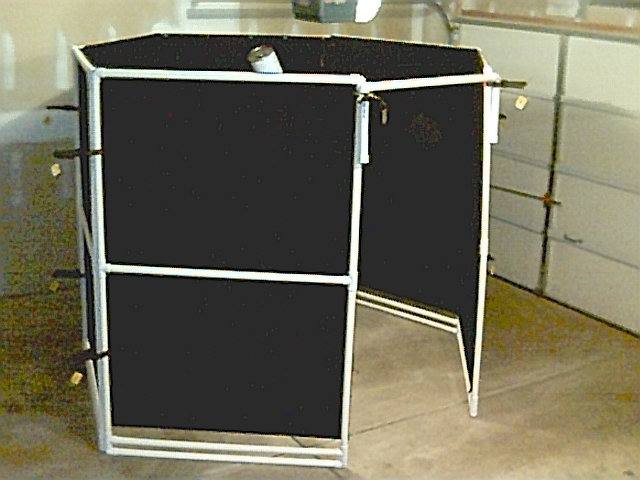Intermarkets' Privacy Policy
Donate to Ace of Spades HQ!
aceofspadeshq at gee mail.com
Buck:
buck.throckmorton at protonmail.com
CBD:
cbd at cutjibnewsletter.com
joe mannix:
mannix2024 at proton.me
MisHum:
petmorons at gee mail.com
J.J. Sefton:
sefton at cutjibnewsletter.com
A House Of DEI [Lex]
Hobby Thread - December 20, 2025 [Ornamental Rex]
Ace of Spades Pet Thread, December 20
Gardening, Home and Nature Thread, Dec 20
Getting what you ask for before Christmas, or not
The
Daily Tech News 20 December 2025
We Wish You A Merry ONTmas
Frustration Be Gone Cafe
Jim Sunk New Dawn 2025
Jewells45 2025
Bandersnatch 2024
GnuBreed 2024
Captain Hate 2023
moon_over_vermont 2023
westminsterdogshow 2023
Ann Wilson(Empire1) 2022
Dave In Texas 2022
Jesse in D.C. 2022
OregonMuse 2022
redc1c4 2021
Tami 2021
Chavez the Hugo 2020
Ibguy 2020
Rickl 2019
Joffen 2014
maildrop62 at proton dot me
TBD
Spaced Out Challenge: Comets, Comets, Comets, Comets!
[We Politely Request That All Off-Topic or Political Comments Be Directed to the Thread Directly Below This One, Which Will Serve Officially as the Current "Active Conversation" Thread for All Discussions Not Related To This Topic.
-- Sincerely, the Fascist MGMT]

Welcome again to the Spaced-Out Challenge. Whether you have a question about a scope, a new astronomical discovery you want to expand on, or just want to kick back and enjoy the cosmos above, come one come all on our weekly journey through space and time. This week's edition will be your all-in-one source for catching a glimpse of not one, not two, not three, but four visitors from the Oort Cloud, including the big tease, ISON.
Note: this is a very, very large edition of our astronomy post, with the intent to answer any and all questions you could possibly have on these elusive and exciting icy visitors. It starts with a general background on comets, then details on the four we are targeting, then where to look, then how to photograph them (and win fabulous prizes), followed by an abbreviated buyer's guide for those of you lacking equipment, washed-out sky observing tips, our traditional closing, and finally the full dark sky directory for those wishing to get out for a better look.
The Guts of a Comet
Comets are large chunks of ices and dust left over from the formation of the solar system that "fall in" from the distant Oort Cloud towards the sun. Their prime components are summed up well in this demonstration by Dr. Amy Manzier of the Jet Propulsion Laboratory:
Comets vary. Dr. Karen Meech explains the difference between the short, long, and "fresh" comets, all of which are in the sky above right now:
The Skinny on Lovejoy, ISON, Encke & LINEAR
Comet C/2013 R1 Lovejoy
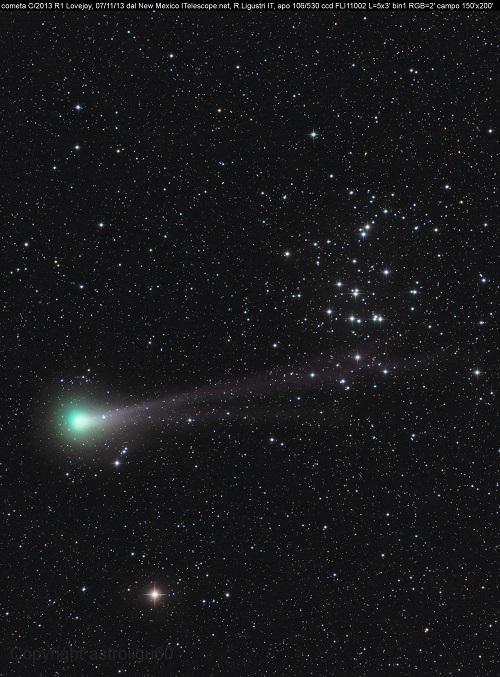
Visible to the naked eye now from an extremely dark spot, obvious in binoculars, and gorgeous in a telescope, Lovejoy has overtaken ISON as the current comet of interest among amateurs.
It's discovery, the fourth by amateur Terry Lovejoy, was reported back in September on UniverseToday, and initial reports missed it's current brightness level by over a magnitude:
The discovery of C/2013 R1 Lovejoy was announced on Sept. 9 after two nights of photographic observations by Lovejoy with an 8-inch (20 cm) Schmidt-Cassegrain reflector. When nabbed, the comet was a faint midge of about 14.5 magnitude crossing the border between Orion and Monoceros. Subsequent observations by other amateur astronomers peg it a bit brighter at 14.0 with a small, condensed coma...And as Stuart Atkinson noted on his website, Cumbrian Sky a great lineup should be in the northern hemisphere skies on November 9, 2013. From the left, Comet Encke will be magnitude 6, ISON should be at about magnitude 6 or 7; then Mars, followed by the new Comet Lovejoy, which will be still very faint at around magnitude 9, topped off by a bright Jupiter. The comets will not likely be of naked eye visibility, but this should be a great chance for astrophotographer to capture this lineup!
Tony Flanders recently observed all four of these comets from a site in suburban Boston, and was most impressed with Lovejoy:
Comet Lovejoy (C/2013 R1) is a real humdinger — almost as bright now as Comet ISON was forecast to be -- which is to say, about 10 times brighter than ISON actually is. This morning Lovejoy was in the same binocular field of view with M44, the Beehive Cluster — an incredible view. The comet is big, bright, and gorgeous, with a diffuse but fairly long tail.Moreover, Comet Lovejoy C/2013 R1 (not to be confused with other famous comets discovered by Terry Lovejoy) is very well placed in the predawn sky, high in the southeast near the Leo/Cancer border. If you prefer staying up late to getting up early, Lovejoy is reasonably high in the east by 1 a.m. at mid-northern latitudes.
Naked-eye visible now in exurban and rural skies, can be seen with binoculars in any sky.
Comet 2P/Encke, Old Faithful
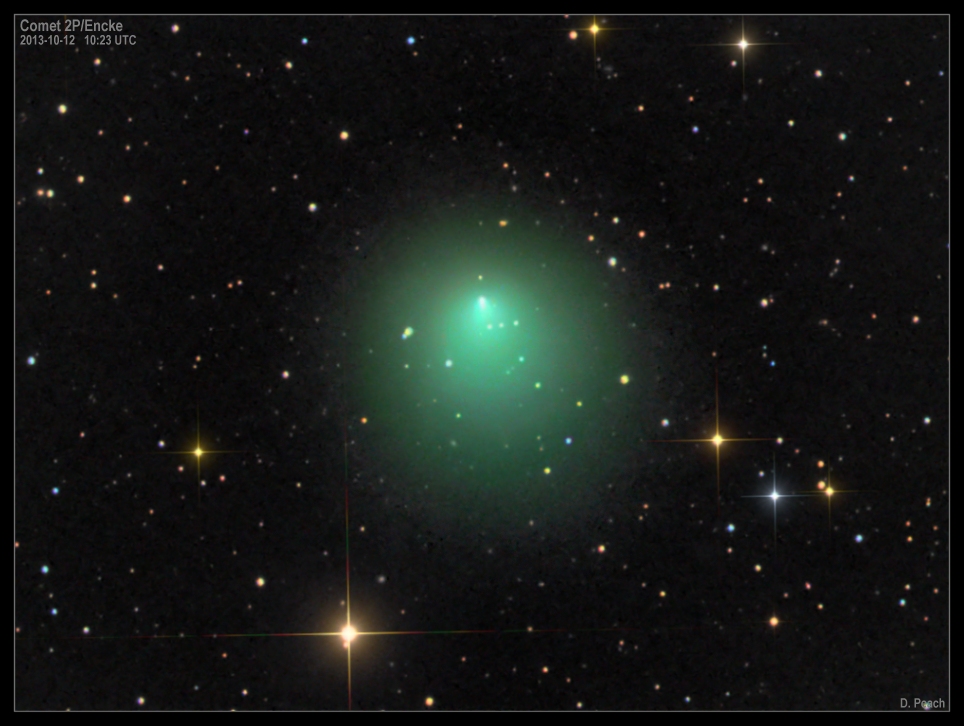
Comet 2P/Encke, first discovered in 1786 by Pierre Méchain and recognized as a periodic comet by Johann Franz Encke in 1819, holds the record for the shortest period of any known comet at just over three years. Comet Halley by comparison makes an appearance every 75-76 years. Encke never becomes spectacularly bright, but makes for a great binocular target, currently at magnitude 7. Universe Today explains why this years' apparition is so special:
this year’s apparition of Comet Encke is especially favorable for northern hemisphere observers. This is due to its relatively high orbital inclination angle of 11.8 degrees and its passage through the morning skies from north of both the ecliptic and the celestial equator. Encke is about half an A.U. ahead of us in our orbit this month, crossing roughly perpendicular to our line of sight.
Note that Encke is also running nearly parallel to Comet ISON from our vantage point as they both make the plunge through the constellation Virgo into next month. Mark your calendars: both ISON and Encke will fit into a telescopic wide field of view around November 24th in the early dawn. Photo-op!
As of this writing, it is the second-brightest comet visible. From Tony Flanders' observations:
Comet 2P/Encke is painfully low at the onset of astronomical twilight, but also quite handsome. Its head is considerably smaller but brighter than ISON's, standing out well against the brightening sky.
Visible in binoculars from exurban and rural areas, small telescope everywhere else
Comet C/2013 X1 LINEAR explodes on the scene

LINEAR was never expected to become anything spectacular, and it's very low proximity to the horizon will still make it a difficult one to tease out, but it underwent a spectacular explosion on October 22nd, jumping from magnitude 14 (too faint to see with an 8" telescope) to magnitude 8 (visible in binoculars) overnight. The British Astronomical Association has a great compilation of images that show the dramatic flare up that earned this wanderer a spot on this special edition of Spaced Out Challenge. Photographers, now is your time to catch it: the outburst will begin to subside and it will begin to fizzle. It is the most difficult comet to catch of the four, and a blunt Tony Flanders, in the aforementioned article, named it as the one to skip if you had limited observing time.
Binocular object in all but very bright skies.
Comet C/2012 S1 ISON: the Great Tease
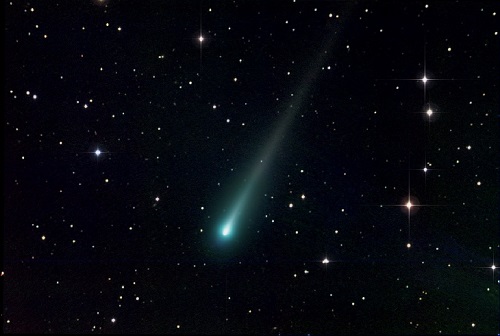
Let's go back to September 2012, when Sky and Telescope writer Kelly Beatty did his best to contain his excitement over it's initial discovery:
It was first spotted as a faint, 18.8-magnitude object in images taken by Vitali Nevski (in Belarus) and Artyom Novichonok (in Russia) using a 16-inch (0.4-m) reflector that's part of the worldwide International Scientific Optical Network (ISON). "We could not be certain that it was a comet," Novichonok explains, "because the scale of our images is quite small [2 arcseconds per pixel], and the object was very compact."The next night they confirmed its cometary nature using the larger reflector at Majdanak Observatory in Uzbekistan, but by then other astronomers had done likewise. According to naming conventions established by the International Astronomical Union, that one day of uncertainty led to the comet being generically named "ISON" instead of "Nevski-Novichonok". Its formal designation is C/2012 S1.
Naming uncertainties aside, we already know a lot about this object, thanks to two sets of prediscovery images dating to last December and January. The comet is inbound from the Oort Cloud and will pass very close to the Sun — just 725,000 miles (1.2 million km) from its white-hot photosphere — on November 28, 2013. Before then and thereafter (if it survives perihelion), Comet ISON could put on a spectacular show.
In fact, the geometry could make C/2012 S1 a "dream comet," as one eager skywatcher has commented, because it will swing just 40 million miles (0.4 astronomical unit) from Earth a few weeks after perihelion, when it will be high in moonless, northern skies after sunset. Initial predictions by the IAU's Minor Planet Center suggest that Comet ISON could peak at magnitude –10 or brighter at perihelion (when it will be just 1° from the Sun), and that it could remain visible to the unaided eye from early November to the first weeks of 2014.
And then, it failed to brighten as initially hoped. However, comets by their nature are extremely unpredictable, and S&T's senior editor Alan MacRobert felt compelled to set things straight on the known knowns, known unknowns, and unknown unknowns regarding the Great Tease of 2013:
Finally, in the last week or so, ISON has finally begun to brighten, with a current magnitude estimate of around 8, placing it well within range of binoculars from dark sites (see the end of this thread for such places). It's peak brightness remains a mystery, as will it's fate when it skims dangerously close around the outer atmosphere of the sun at the end of the month. It could break up and form a wondrous spectacle in the sky like Comet Lovejoy in 2011, or it could fade off into the darkness. We simply won't know for sure for another three weeks. In the meantime though, it is making for a steadily improving and impressive sight in backyard telescopes.
From Flanders' observations:
ISON...has indeed improved a lot in the last few weeks. I swept it up easily in my 7-inch Dob at 28X, and it was quite handsome at 120X, with a 3' head and a bright, starlike pseudonucleus. I didn't see any sign of a tail. I tried and failed to see it with my 10x30 binoculars; it might be possible in a darker sky [again, Flanders was observing from suburban Boston]... I think that ISON should be pretty easy to spot in a telescope now from a typical suburb, assuming you have a low eastern horizon.
Binocular object from rural and dark skies, visible now in small telescopes from any sky, brightening to at least a binocular object from any sky by months' end.
Where to Look
Up. More specifically, these comets will be best seen in the morning pre-dawn and twilight hours, as they dive closer towards the sun. Comet ISON will be at its most brilliant the day after Thanksgiving, but will be to close to the sun to see practically.
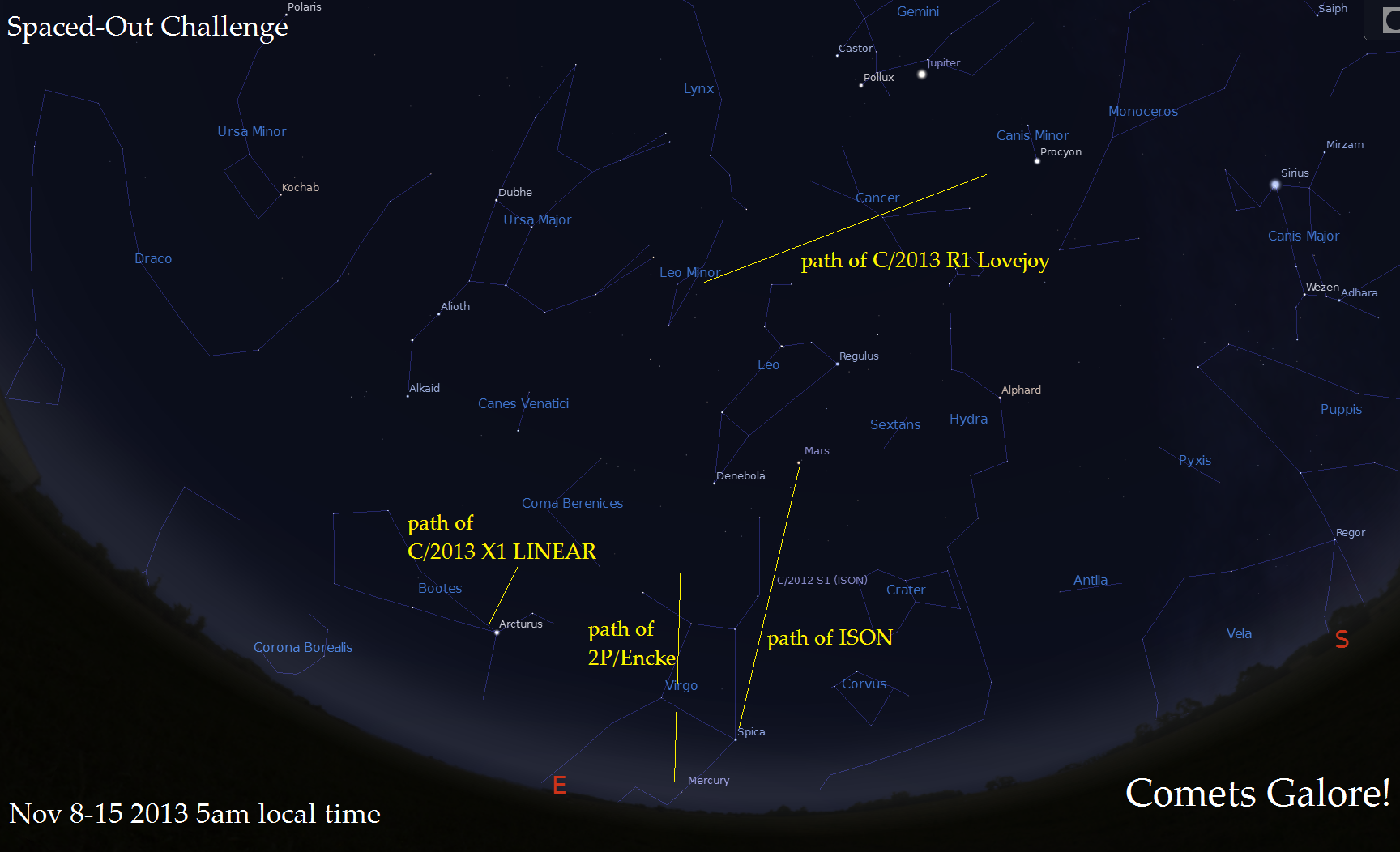
Greg Crinklaw has an unbeatable chart of the exact where-when-what for looking at all of these comets, including fantastic PDF finder charts I will link directly below. Simply orient yourself towards the East, refer to these charts, and start hunting. Can you catch all four?
Skyhound's ISON Chart
Skyhound's X1 LINEAR Chart
Skyhound's Lovejoy Chart
Skyhound's 2/P Encke Chart
Photographing the Comets & Various Contests
I'll admit my knowledge with astronomy is limited to just the visual side, but that doesn't mean I can't forward you to the most extensive guide to photographing a comet you'll ever come across, courtesy the Waiting for ISON blog. So no excuses for you Walt. Get on it.
Even if ISON proves a fizzler, if you've got a camera and want some green, there are multiple contests with fantastic prizes worth entering.
Sky and Telescope offers an 8" Celestron EdgeHD as it's grand prize.
UniverseToday & OPT offers an assortment of prizes, top of which is a fantastic all-in astrophotography bundle.
Lastly, Discover Magazine and the National Science Foundation are offering cash prizes for top pics.
Abbreviated Buyer's Guide
The extensive Beginner's Buyers Guide has even more to offer, but I'll recap on a few potential buys for catching the comets.
Binoculars
There are several cheaper options on the original buyer's guide, but several readers have been wowed by these:
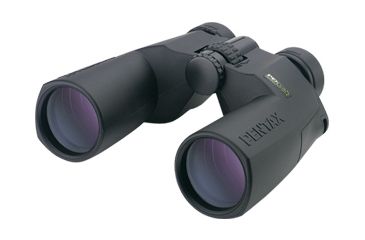
$160. Excellent, excellent, excellent binoculars, especially for the price. From the feel to the surprising light weight to the high-performance optics, if you have the scratch, spend it. They easily out-perform binos selling for three times as much, but that's Pentax for ya.
Telescopes
The scopes listed in the original thread are all still great, but here's some new additions the list, and a price drop alert for ya.
$199, shipping November 26th.
While I haven't tested it yet, Orion's 90mm refractors have been decent peformers, and the alt az slow motion knobs and decent tripod will make for a fantastic grab-and-go.
$80 shipped from Amazon
The kid in the video tells it all: light, compact, easy to use, and powerful for a scope of such small size.
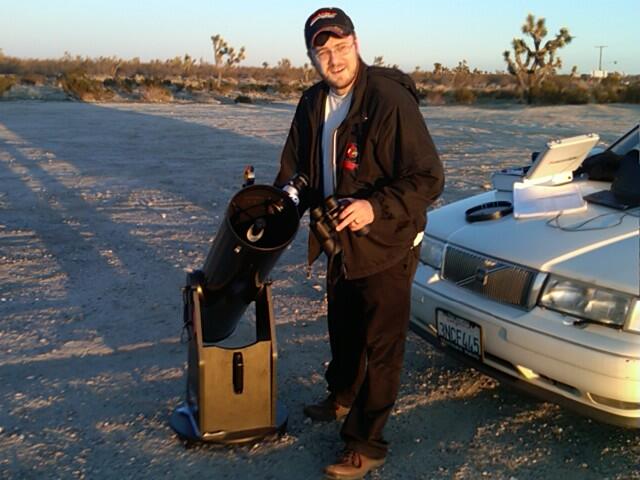
The best introductory amateur telescope sold in the last hundred years. Tough. Large. Extremely easy to assemble and use. Highly adaptable. Intimidating to your neighbors.
To update from my original gushing pitch on, hands down, my favorite telescope out there, it is now selling for just $330 shipped. Best bang for the buck, but remember: it's a big lady.
CBD alerted me to a sale on Costco for the Celestron 130EQ telescope. Normally I'd say pass, but for $160 shipped, they also throw in a half-decent accessory kit, so not bad for a "department store" scope. Celestron's "Costco 102" is unfortunately no longer available (though you can find one if you're lucky on eBay from time to time), so this is the best I've seen advertised for such stores.
Eyepieces and Fliters
$130 shipped from Astronomics. There are a few "beginners kits" out there, but none have the bonus of a great "wide-field" eyepiece and at least two with great eye relief. Included eyepieces are 6mm, 9mm, and 40mm plossls, and one 15mm 68degree Superview. Four colored filters for aiding planetary observing, a moon filter, and a barlow lens round out the kit. The 6 and 9 mm have only 3mm of eye relief, but the rest of the kit more than makes up for this shortcoming.
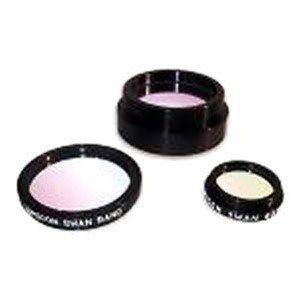
$130 from Amazon/AgenaAstro
Cuts through some of the clutter and improves viewing of the coma and tail. Also comes in a 2".
$170 shipped from Hayneedle
Planetaries that rival eyepieces costing 5x as much, with a padded carry bag?. The Z series offers nearly an inch of eye relief, 55 degrees of apparent field of view, and have gotten rave reviews from the amateur community.
Comet Viewing for Urban Observers
As Flanders had indicated, getting away from bright lights is ideal, but not necessary for enjoying these visitors now through December. Blocking stray light will make teasing them out of the sky a lot easier, along with getting your eyes dark adapted. I've reposted a few relevant tips and tricks from the original Washed Out Sky post, and included a painfully easy one I plumb forgot:
Get Your Eyes Adapted
Our eyes have an incredible ability to adjust to darkness. After a good half-hour from a very dark site, we can even eyeball Uranus, which rarely brightens beyond magnitude +5.7. The same holds true in urban environments, if we protect ourselves from bright lights. I suggest buying Orion's AstroGoggles:
At only $19.99, they help your eyes adjust and stay dark adapted even when checking your cell or walking inside the house for a coffee. Oversizing makes them an ideal option for eyeglass wearers. You may look a member of DEVO wearing them, but nobody said astronomy was high fashion.Build a Light Barrier
Eff off, neighbors!
If you live off a busy street like me, the constant stream of cars can make a long night of observing a headache. Or perhaps you have that neighbor who insists on leaving his floodlights on. Building your own portable light shields is a cost effective way to eliminate these sources of nuisance light. John Duchek at CloudyNights has a great step-by-step build guide for making your own light shields. I've modified it a bit to include his "updated" bits (they were a work in progress with his initial publication) and current prices for all required materials. You can make four of these light shields for less than $100 and they are incredibly effective:
When I can get fully dark adapted, I can see magnitude 5.2 stars from this site so the sky can be seen reasonably well if the light trespass from the neighbors can be blocked. In addition cars pass by at irregular intervals. To stop the light trespass, I have built 6.5'x 5' light shields at a cost of about $10-15 each. The first one is somewhat more expensive since you may have to buy the "general equipment". Each takes 1.5-2 hours to build if all parts are present...
Initially, three of these devices have been successful at shielding me from all of the lights above and all car lights going by my house. I can now remain with dark adapted eyes for hours in my neighborhood...
To build a 6.5 foot x 5 foot light shield, you need the following:General equipment:
Can of PVC cement $4.50 (good to make many light shields)
1 roll (10ft x25 ft) of 3 mill black plastic sheeting (enough for 8 shields) [$10] Some of the black plastic I saw was not opaque and let a little light through. Check that it is opaque before you buy.
Hack saw [$7]For each shield you need the following:
3 x10ft pieces of 1" PVC pipe $10 total
4 x1" PVC Tees $2.50 total
2 x" PVC 90 degree elbows $1.20 total
15 inches of Velcro tape [buy industrial grade $8-$18]Directions:
Cutting:
Cut 1 PVC pipe into 2 x 5'0" pieces
Cut 5'7' pieces from the other two 10 foot pipes
From one of the 4 ' 5" remnants, cut 2 x 6" pieces and 3 x 1 foot pieces
From the second remnant, cut 1 additional 1 foot piece
Gluing:
Glue 90 degree elbows to each end of 5 foot section (be sure they point same way) (Piece #1)
Glue the center hole of tee to each end of the other 5 foot section (be sure that they line up parallel as in picture) (Piece #2)
Glue 2 1 foot section in to ends of 3rd tee
Glue 2 1 foot section in to ends of 4th tee
Glue 6 " piece into center hole of parts from step 3 and 4 (Piece #3 and #4)
The two 5'7" pieces are pieces 5 and 6.Once the glue has dried, the frame is assembled. I put a very small amount of grease on the unglued joints to be sure I can easily separate them when desired...[cut 12 1" strips of velcro] use a good contact cement, paint on both the pipe and back of Velcro, allow to get tacky, and press together. A rubber band is useful to hold the Velcro fast until it has completed the drying process...
Assemble the frame as in the pictures. Here is a picture of a completed single frame unit.
Cut a 6 foot piece of the black plastic off the roll. Hang the strip (it is 10 foot wide) over the frame so that both sides are equal. Cut the plastic sheet in half. This gives you two 6 foot x 5 foot sheets. [Line up] one of the sheets (five foot part horizontal) to all 12 strips of velcro, [staple identically sized velcro strips to light shield frame, line up,] and your light shield is complete. You may or may not wish to trim the bottom inch or two off the bottom of the sheet. (mine drag the ground by about an inch and keep ground level light our nicely.
Light barriers can be built with more durable materials, but if you're on a budget, 3mil and pvc can't be beat. If your own outdoor lighting makes observing difficult, Lowes now offers IDA-approved dark-sky friendly lighting mounts that can greatly improve your backyard sessions too.
Protect Your Instrument from Stray Light
Washed-Out Astronomer's $5 Shield
Reflector telescopes often have the secondary mirror and focuser close to the open end of the telescope. This puts both at risk of being impacted by stray light. A simple solution to this is making yourself a "light shield" that effectively extends your telescope tube and eliminates this risk. The Washed-Out Astronomer offers this great $5 DIY light shield project:
Step one is to acquire or fabricate a rectangle of black poster board paper of the appropriate size. The end ring of my telescope tube has an outer circumference of 38.5 inches. Allowing some excess for gluing, I needed a rectangle of poster paper about 42 inches wide. The common wisdom is that the front of the telescope tube should extend a full tube diameter beyond the focuser. So for my telescope that meant the rectangle should be at least 12 inches long.
At the local arts and crafts store, I found sheets of 22 x 28 inch poster board paper. I glued two of these together to make a 42 inch wide sheet. I used ordinary white glue to join the sheets. Don’t make the overlap too big and apply the glue evenly but sparingly. Otherwise the overlapped section will be rather stiff and hard to shape into an arc of a cylinder (I overlapped about 3 inches). Be sure to join the two sheets squarely. After the seam dried, I overlaid the each side of the seam with packing tape...
After gluing, I had a 42 x 22 inch sheet...I then shaped the big sheet into a cylinder and glued it. To hold it while the glue set, I used clothes pins to clamp the top and bottom of the seam, added a little tape in the middle, and then laid the cylinder, seam side down, on the floor with a couple of liter bottles of water inside the cylinder on top of the seam to keep pressure on it. Once the seam was dry I again taped it on both sides. To keep the cylinder ends from fraying, I also taped the rims all around. It was almost finished—almost, but not quite.
The final step was to try it on for fit. My intention had been to have the extension tube fit snuggly around the top end ring of my telescope and have it rest against the four "nuts" that anchor the secondary vanes. Unfortunately, the fit was a bit too loose. To make it a snug fit, I originally planned to line the inside bottom area of the cylinder with foam. But then I realized that the fit was loose enough that I could actually wiggle the extension tube over the tops of the four spider vane nuts. That made for a really snug fit and locked the light shield in place very tightly. To keep the nuts from eating into the poster board, I put some tape strips on the inside of the cylinder at the four spots where the nuts rub against the light shield. The smooth tape surface also makes it easier to slide the light shield on and off.
Finally, I marked the outside of the cylinder with white and red crayon (borrowed from my daughter) so that a red flash-light will highlight the taped areas on the light shield. This way even in the dark I can easily align the taped areas with the four nuts. The crayon markings are clearly visible in the photo below showing the light shroud fully seated on the telescope.
WOA lives in suburban D.C., so his site is a must-read for budding astronomers living under less-than-ideal skies. The full step-by-step guide for his shield is here.
Wear an Observing Hood (or a towel)
So easy, I completely forgot it. If building a cheap light shield is too much of a hassle, grab a large, dark towel, and simply don it while observing through your telescope. It may become clumsy navigating around your observing space, but whatever works. Observing hoods are sold online for about $35, if your pocket has any money left to burn after scrambling for optics.
The full Beginner's Buyer's Guide can be found in the master index of all Spaced-Out Challenge threads here, but of course you can always inquire about binoculars, telescopes, and all the rest in the comments. As always, if you have astrophotography, product recommendations, or astronomy news you'd like to see on a future Spaced-Out Challenge, email me at theoneandonlyfinn (at) gmail.com.
Until then, clear skies and keep looking up!
Dark Sky Sites for All 50 States
Regular reader and photographer Matthew Gowan was inspired by the original Perseid thread featuring this list, and decided to track down that dark sky spot in Central Florida I had mentioned, and this was the result.
To save you the hassle of jumping to an older thread, here is the original directory:
While nothing can beat an immaculate night sky, the experience of these flashing visitors streaking through the summer Milky Way can be enjoyed within a reasonable driving distance wherever you may be, weather permitting. Many states and towns have dedicated parks as "dark sky preserves" and are more than willing to accommodate the needs of local amateur astronomers.
Locations marked in italics are among the darkest places in the nation. A few of these have been pulled from Phil Harrington's excellent resource observingsites.com along with the Jshine map, where additional details for access are necessary I've linked to these sites directly. Caution: contact info for most sites is listed, but with ANY rural site be cautious about potentially dangerous unknowns such as blind cliffs and drops. It is strongly recommended you visit a site before sundown to familiarize yourself with your site.
Mobile: Little River State Forest 1 hr NE of Mobile
Montgomery: Grady and environs 45 minutes from Montgomery
Birmingham: Dirt parking lot/turnabout at Alabama 13 x 102 Vehicle traffic at minimum after sundown, 1 hr from Birmingham.
Coffeeville Reservoir Darkest sky in the state, 2 hr N of Mobile.
Go outside of your “town” and look up, so long as you aren't experiencing the Midnight Sun.
Recommended (actively advertising for the Perseids): Eagle River Nature Center
The Grand-Daddy of Dark Sky Destinations, the Milky Way lights up the summer sky everywhere but within the major metro areas (excluding Flagstaff- it's dark sky program means residents can walk to a nice sky).
Phoenix: (DARK sky site with amenities)- Alamo Lake State Park 2.5 hr W of Phoenix
Phoenix/SW Arizona: (DARK sky site go in groups due to desert)- The Antennae Observing Site 1.5 hr W of Phoenix
Phoenix: (closer, brighter dark sky site)- roadtrip W to Wickenburg 1 hr NW
Tucson: Kitt Peak National Observatory (Nightly Observing Program) Call ahead to enjoy a great evening, shuttle service available. Fantastic skies 90 minutes from Tucson.
North: Grand Canyon-North Rim Not only the darkest skies in the state, but some of the darkest on earth.
Northwest: Redding Recreation Area in Ozark
Little Rock: Petit Jean State Park 1 hr drive NW
Texarkana: Millwood Lake (North Side)
Southeast: Scrubgrass Campground One of the darkest in the state, if not the darkest.
Northern California, especially around Shasta, is an astronomer's paradise.
The High Sierras and the Mojave offer spectacular views to visitors and residents alike.
Northwestern: Hyampom Airport
Northeastern: Baum Lake
Bay Area North: Doran Regional Park 1.5 hr N of San Fransisco.
Sacramento: TAC-SEC's Ice House Observation Plateau Sites additional driving directions here
Bay Area South: Henry W Coe State Park 50 minutes from San Jose
Fresno: Spring Cove in Sierra National Forest 1 hr drive from Fresno
Carmel/Salinas/Monterrey: Pfeiffer Big State Beach at Big SurIncredible views of sea, sand and sky an hour south on Rte 1.
Central Coast/San Luis Obispo: Lake San Antonio <1 hr from SLB.
Bakersfield/Kern: Walker Pass Campground <1.5 hr East from Bakersfield. Very dark sky.
High Sierras/Eastern: Grandview Campground Very, very dark skies near Bishop.
Darkest sky in SoCal: Mesquite Spring Campground in Death Valley National Park most recent addition to the International Dark Sky Association's certified parks.
Vandenberg AFB/Santa Maria/Santa Barbara: VAAS' Figueroa Mt Site 1 hr drive from SB/SM/VAFB
Los Angeles/Ventura: Mount Pinos 1.5 hrs NW from downtown L.A. Haven for Angeleno amateur astronomers and astrophotographers.
Orange County/Inland Empire:
(Mountains)-Silverwood Lake Cedar Dam area.5-1hr from I.E. cities
(Desert-North) Amboy Crater Town of Amboy with iconic Roy's Gas, cold water and snacks nearby. Bathrooms and fountains. Parking area is remote, about a half mile from Route 66 which itself is rather remote. This is the darkest point in California south of Death Valley.
(Desert-South) Joshua Tree National Park Cottonwood Campground 1.5 hr E of Riverside
San Diego: Anza-Borrego Desert SP and environs 1.5 hr from downtown SD. Community within park also a great dark sky spot.
Outside of the Fort Collins-Pueblo string of cities, a five minute trip outside town gives you pristine skies.
Denver: Caribou Ranch Open Space 1.5 hr W of downtown Denver
Colorado Springs: Eleven Mile State Park 1 hr drive from Colorado Springs
Comanche National Grassland Darkest site in Colorado, one of the darkest in North America.
White Memorial Conservation Center, Litchfield, CT Darkest easy-access site in the state. Milky Way visible from here. <1 hr drive from Hartfort, Bridgeport, or New Haven.
Trap Pond State Park near Laurel Yep, even Delaware has some darkness.
W of I-75 and N of Rte 98 is almost entirely dark sky. Wilderness snaking through the lower middle around Lake Okeechobee. If your town is within these areas, huzzah.
Panhandle: Falling Waters State Park <1.5 hr from Pensacola
Tallahassee: Bald Point State Park- Sunrise Beach Access parking lot and point are unlocked after hours per park staff, park in specified area. Very dark skies less than an hour from Tallahassee.
Jacksonville: Goldhead Branch State Park 1 hr drive time, reasonably dark skies.
Gainesville/Ocela: Shired Island 2hr drive time, darkest skies in the state.
Tampa Bay: Duette Preserve Parking Area closed at sundown, lots open 24/7. 1 hr drive time from Tampa/St Petersburg.
Orlando: Lake George State Forest 1.5 hr drive time
Naples and Miami: Kirby Storter Roadside Park 1 hr W of Miami, E of Naples on the 41.
Key West: Spanish Harbor KeyThe Girl Scout Camp here is used for the Winter Star Party.
If you can afford the trip: Dry Tortugas National Park. A challenge to get into, but one of the darkest sites on earth.
Great skies in the north along the Smokies, the southern border with Florida is swampy but dark as well.
Atlanta/Macon/Augusta/Athens: Ocatee Observing Field Within 1.5 hr drive from all of these cities.
Valdosta: Stephen C Foster State Park <1.5 hr east of Valdosta, darkest in the state.
Southwest/Columbus: Providence Canyon State Park (overlooks) <1 hr from Columbus STAY IN THE PARKING/OVERLOOK AREA. CANYON DROPS SUDDENLY.
If you can't get atop Mauna Loa:
Haleakala National Park next-darkest in the state, one of the darkest in the US.
Another state with incredible skies throughout, there is a small region in it's SW corner, bordering Nevada, that is one of the darkest sites on earth:
Duck Valley Indian Reservation Mountain View Reservoir Bortle Zone 1 Sky
Chicagoland: Green River Conservation Area near Dixon <2 hrs West
Central: Jim Edgar Panther Creek State Conservation Area
Southern: Shawnee National Forest Darkest skies in the state.
North: Potawatomi Wildlife Park First Dark-Sky Preserve in Indiana <1hr from South Bend, 1 hr from Ft Wayne
Indianapolis/Central: Camp George Cullom in Frankfort <1 hr from downtown Indianapolis
South:Patoka Lake & Environs <1.5 hr from Evansville, Bloomington
Much of Iowa is blue/green zone outside of the towns and cities.
Eastern: Buzzard Ridge Wildlife Area <1.5 hr from Cedar Rapids, Iowa City, Davenport
Central/Des Moines: Springbrook State Park 1 hr from Des Moines
Western: Thul Woodland 1 hr from Souix City
Nine Eagles State Park Darkest site in Iowa
Virtually anywhere 15 minutes outside of town (western three fourths of the state)
Nearest Wichita: Cheney just 25 miles West.
Topeka/KC: Hwy 99&Cyclone Very dark sky
Plenty of rural locations, especially in the eastern third.
Eastern: End of Chimney Top Road in Daniel Boone National Forest
Western: Land Between the Lakes Recreation Area
North: Caney Creek Lake State Park
Central: Catahoula Lake in Catahoula NWR
New Orleans: Delta NWR <1.5 hr from downtown
West: Rockefeller State Wildlife Refuge and Game Preserve
Northern half of the state is near-pristine.
Acadia National Park Darkest easy-access site in the state.
Baltimore Metro: Green Ridge State Forest near Flintstone, MD Darkest sky in the state.
Southern/DC Metro: Point Lookout State Park
Eastern Shore: Tuckahoe State Park near Denton
Shady Pines Campground, near Savoy, MA Darkest sky in the state, <2hr drive time to Boston
Marconi Beach <90 mins from Boston
Detroit Metro: Lake Hudson State Recreation Area The First Dark Sky Preserve in Michigan. 90 minutes from Detroit, 1 hr from Ann Arbor
North/Central: Lumberman's Monument National Forest Svc. Campground & Park
Upper Peninsula: North Country Natl Scenic Trail- Hiawatha National Forest Darkest Site in Michigan
Another state dominated by darkness with too many sites to list.
Duluth: Savannah Portage State Park
Twin Cities: Father Hennepin State Park 1.5 hr N of Minneapolis-St Paul
NW: Old Mill State ParkVery dark, almost "disorienting".
Voyaugers National Park Redefines the definition of dark. Incredible site, darkest in the state.
Extensive forest makes for dark but obscured viewing in much of the state, but most fishing lakes and reservoirs throughout offer decent horizons and dark skies.
Biloxi: De Soto National Forest Any open lot within the park, about an hour north.
Jackson: Lake Lincoln State Park 1 hr S of Jackson
Near Kansas City: Refer to the KANSAS listing for Topeka for a close point west, within MO closest site is Bunch Hollow Conservation Area
Near St Louis Metro: Council Bluffs Recreation Area DARK site 2 hrs from STL
Near St Louis: Cuivre River State Park 1 hr from downtown
Most of Missouri in between the big cities is blessed with good skies once you get about five minutes away from bright lights. There is one place though which is pure magic.
A very specific spot in the Ozark National Scenic Riverways Darkest sky in the state, one of the darkest along the Mississippi.
Virtually anywhere
UL Bend National Wildlife Refuge Darkest sky in the state
Virtually anywhere 15 minutes outside of town (western two-thirds of the state)
Nearest Omaha: Burchard Lake Dam
Merritt Reservoir Darkest sky in the state
Austin, NV Darkest site in the state.
Las Vegas Metro: Glendale/BLM area
Most parts north of the NH/MA line are in the green.
Dixville Notch State Park Darkest site in the state
North: Jenny Jump State Forest near Hope
South: Belleplain State Forest (recreation fields) near Woodbine darkest site in the state
Much of the state is extremely dark, but here are few notable spots.
Northeast: Clayton Lake State Park Very dark sky.
Santa Fe/Las Vegas: Fort Union National Monument
Albequerque: San Lorenzo Canyon
Alamagordo/South: Three Rivers Petroglyph Rec Site
Southeast: Carlsbad Caverns Visitor Center
Gila Cliff Dwellings National Monument Among the darkest places on earth. Milky Way takes on a three dimensional appearance.
Northern New York: Adirondacks, Darkest site in New York State is arguably Raquette Lake.
Western New York: Long Point State Park near Bemus Point
Long Island: Custer Institute in Southold Milky Way is visible here, <2 hr drive from NYC
Southern New York/Closest DARK site to New York City: Pepacton Reservoir <2.5 hr drive time from downtown Manhattan
Western/Asheville: Wayah Bald Darkest point in the Smokies
Northwestern: Doughton Park
Eastern: Pettigrew State Park near Creswell Very Dark Skies
Central/Charlotte/Winston-Salem/Raleigh/Greensboro: Roy J Maness Nature Preserve Within a 1.5 hr drive from all of these cities.
Wilmington/Southern: Bladen Lakes State Forest 1 hr from Wilmington
Outer Banks: National Seashore Cape Hatteras- Ocracoke Island Campsites One of the best dark sky sites in the United States. Eastern sky is immaculate.
Virtually anywhere 10 minutes outside of town
Little Missouri National Grasslands Darkest sky in the state
NW/Toledo: Harrison Lake State Park <1 hr from Toledo
Columbus: Woodbury Wildlife Area <1.5 hr east of downtown
Cincinnati: Stonelick Lake State Park Less than 50 minutes from downtown, best site in SW Ohio.
Cleveland: Dorset Wildlife Area Parking Lot <1 hr from downtown
SE/Appalachia: Lamping Homestead Picnic Area, Wayne Natl Forest Darkest site in the state.
Virtually anywhere 10 minutes outside of town west of Oklahoma City-Tulsa
Nearest Oklahoma City/Tulsa: Robbers Cave State Park Closer spots lie between Holdenville and McAlister, but this is the closest dark campground area.
Black Mesa State Park One of the darkest skies on earth. Words fail.
Eastern Oregon, from Bend on, is some of the darkest sky on earth.
Near Portland: L.L. Stub Stewart State Park <40 minutes from downtown.
Southern/Central: Crater Lake National Park Incredible skies, to it's south east some of the darkest on earth.
Cherry Springs State Park The darkest site in Pennsylvania, and one of the darkest in the Eastern United States. Second International Dark Sky Park named.
Scranton: High Knob Overlook
Pittsburgh Area: Ryerson Station State Park <1.5 hrs from downtown
Philadelphia Area: Hawk Mountain Road, State Game Lands Area #106 <1.5 hr from downtown Philly
Harrisburg/Gettysburg: Pine Grove Furnace State Park
York/Lancaster/AmishMafiaVille: Susquehannock State Park
Frosty Drew Obeservatory, Charlestown, RI Darkest site in Rhode Island, Milky Way is visible from here. <1 hr from Providence.
Western: Bad Creek DamVery dark sky, access road provided by Duke Energy, <2 hr from Spartanburg
Columbia and Charleston: Lone Star Ghost Town Not quite dead yet, but plenty of open spots for parking and observing. 1 hr from Columbia, 70 minutes from Charleston.
Virtually anywhere 10 minutes outside of town
Rabbit Creek Reservoir Darkest sky in the state
Western/Memphis: Chickasaw State Park (around Lake Placid) 1.5 hr east of Memphis
Nashville/Central: Water Valley Overlook on Natchez Trace Pkwy milepost 411.8, 1 hour from Nashville.
Eastern/Chattanooga/Knoxville: Cherohala Skyway Turnoffs Darkest location in the state.
West Texas has incredible sky, just ask any Texan. Even in the more "congested" parts of the state there are some great sites within a short drive.
Big Bend National Park- Persimmon Gap Picnic Area Mind-blowingly dark.
Amarillo: Rita Blanca National Grassland Very, very dark sky. 2 hr drive N to near OK border.
Dallas/FtWorth/Austin: Hubbard City Lakes
Houston: Lake Livingston (North End)
San Antonio/Laredo/Corpus Christi: Big Alamo Tank
Dark skies abound out here, but if you live in Provo/SLC you'll need more of a drive (about an hour) to get away from the lights. One immaculate site near the metro area can be found here. One of the darkest skies on earth can be found towards its southern border.
National Bridges National Monument The first International Dark Sky Park, and for damn good reason. Incredible scenery topped only with near-perfect skies.
Bryce Canyon National Park Darkest spot in Utah, one of the darkest on the continent.
The middle of the state is best, as light pollution from Montreal begins to brighten the northern third.
Branbury State Park Darkest in the state.
Western: Whitetop Mountain Arguably the darkest site in Virginia. Spectacular views.
Northern: Shenandoah National Park-Matthews Arm Campground drivetime 2hrs from downtown D.C.
Metro Northern VA: Sky Meadows State Park <1 hr from Arlington.
Central: Bear Creek Lake State Park
Eastern/Delmarva: Savage Neck Dunes parking lot Very dark considering it is less than an hour from Norfolk.
From Mt St Helens to the NE third, much of the state is an astronomer's paradise.
Tacoma/Seattle: Lake Easton State Park 1 hr from Seattle, 1.5 Tacoma
Spokane: Fishtrap Lake Parking Lot <30 minutes from downtown Spokane
Palouse Falls Darkest site in the state.
Charleston/West: Calhoun County Park Sky can rival Spruce Knob depending on weather.
Spruce Knob and environs The darkest site east of the Mississippi River.
Nearly all of SW and NW (particularly near Kickapoo) has excellent dark skies, the same for the regions bordering Michigan and the Iron Range.
NE Wisconsin: Newport State Park (call ahead)
Green Bay: Kroenke Lake SNA 1 hr from Green Bay
Milwaukee Metro: Kettle Moraine State Forest (North) 45 mins from Milwaukee, Fon du Lac, Sheboygan
Madison/Janesville: Magnolia Bluff Park
The Darkest Site in Wisconsin, Chequamegon National Forest
One of the few states where I can't really point out the "darkest" sky.
Hwy 131 leaving Lander south is one of the darkest of the dark.
JB1000: "I am entertaining a theory (Conspiracy?). When som ..."
All Hail Eris, She-Wolf of the 'Ettes 'Ettes : "Combine all three and I'm THERE, Perf. ..."
[/i][/s][/b][/u]blaster - [b]Fortis Fortuna Adiuvat[/b]: "Gunless is a funny little Western. I recommend it ..."
All Hail Eris, She-Wolf of the 'Ettes 'Ettes : "Looking at "2025 in Film" on Wiki. My nominatio ..."
BurtTC: "I read somewhere that A3 is underperforming. Don't ..."
Blonde Morticia's Phone: " Evening, all. We all know that Sydney Sweeney is ..."
Wolfus Aurelius, Dreaming of Elsewhere [/i] [/b] [/s]: "[i] I liked the previous two Knives Out movies. P ..."
Guy Patterson: "Posted by: Case at December 20, 2025 09:51 PM (G1O ..."
BurtTC: "128 122...yes FRANKENSTEIN will get a bunch of nom ..."
Just Some Guy: "Today I revisited a nifty oldie with Bogart, Glori ..."
M. Gaga: "The Netflix-produced limited series "Ripley" IMHO ..."
A House Of DEI [Lex]
Hobby Thread - December 20, 2025 [Ornamental Rex]
Ace of Spades Pet Thread, December 20
Gardening, Home and Nature Thread, Dec 20
Getting what you ask for before Christmas, or not
The
Daily Tech News 20 December 2025
We Wish You A Merry ONTmas
Frustration Be Gone Cafe
Paul Anka Haiku Contest Announcement
Integrity SAT's: Entrance Exam for Paul Anka's Band
AllahPundit's Paul Anka 45's Collection
AnkaPundit: Paul Anka Takes Over the Site for a Weekend (Continues through to Monday's postings)
George Bush Slices Don Rumsfeld Like an F*ckin' Hammer
Democratic Forays into Erotica
New Shows On Gore's DNC/MTV Network
Nicknames for Potatoes, By People Who Really Hate Potatoes
Star Wars Euphemisms for Self-Abuse
Signs You're at an Iraqi "Wedding Party"
Signs Your Clown Has Gone Bad
Signs That You, Geroge Michael, Should Probably Just Give It Up
Signs of Hip-Hop Influence on John Kerry
NYT Headlines Spinning Bush's Jobs Boom
Things People Are More Likely to Say Than "Did You Hear What Al Franken Said Yesterday?"
Signs that Paul Krugman Has Lost His Frickin' Mind
All-Time Best NBA Players, According to Senator Robert Byrd
Other Bad Things About the Jews, According to the Koran
Signs That David Letterman Just Doesn't Care Anymore
Examples of Bob Kerrey's Insufferable Racial Jackassery
Signs Andy Rooney Is Going Senile
Other Judgments Dick Clarke Made About Condi Rice Based on Her Appearance
Collective Names for Groups of People
John Kerry's Other Vietnam Super-Pets
Cool Things About the XM8 Assault Rifle
Media-Approved Facts About the Democrat Spy
Changes to Make Christianity More "Inclusive"
Secret John Kerry Senatorial Accomplishments
John Edwards Campaign Excuses
John Kerry Pick-Up Lines
Changes Liberal Senator George Michell Will Make at Disney
Torments in Dog-Hell
The Ace of Spades HQ Sex-for-Money Skankathon
A D&D Guide to the Democratic Candidates
Margaret Cho: Just Not Funny
More Margaret Cho Abuse
Margaret Cho: Still Not Funny
Iraqi Prisoner Claims He Was Raped... By Woman
Wonkette Announces "Morning Zoo" Format
John Kerry's "Plan" Causes Surrender of Moqtada al-Sadr's Militia
World Muslim Leaders Apologize for Nick Berg's Beheading
Michael Moore Goes on Lunchtime Manhattan Death-Spree
Milestone: Oliver Willis Posts 400th "Fake News Article" Referencing Britney Spears
Liberal Economists Rue a "New Decade of Greed"
Artificial Insouciance: Maureen Dowd's Word Processor Revolts Against Her Numbing Imbecility
Intelligence Officials Eye Blogs for Tips
They Done Found Us Out, Cletus: Intrepid Internet Detective Figures Out Our Master Plan
Shock: Josh Marshall Almost Mentions Sarin Discovery in Iraq
Leather-Clad Biker Freaks Terrorize Australian Town
When Clinton Was President, Torture Was Cool
What Wonkette Means When She Explains What Tina Brown Means
Wonkette's Stand-Up Act
Wankette HQ Gay-Rumors Du Jour
Here's What's Bugging Me: Goose and Slider
My Own Micah Wright Style Confession of Dishonesty
Outraged "Conservatives" React to the FMA
An On-Line Impression of Dennis Miller Having Sex with a Kodiak Bear
The Story the Rightwing Media Refuses to Report!
Our Lunch with David "Glengarry Glen Ross" Mamet
The House of Love: Paul Krugman
A Michael Moore Mystery (TM)
The Dowd-O-Matic!
Liberal Consistency and Other Myths
Kepler's Laws of Liberal Media Bias
John Kerry-- The Splunge! Candidate
"Divisive" Politics & "Attacks on Patriotism" (very long)
The Donkey ("The Raven" parody)


